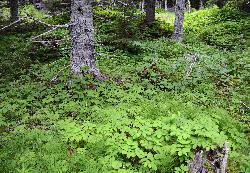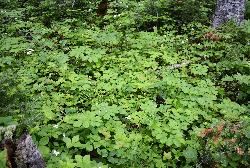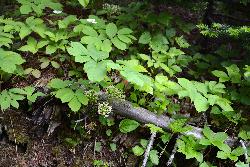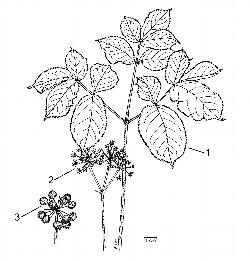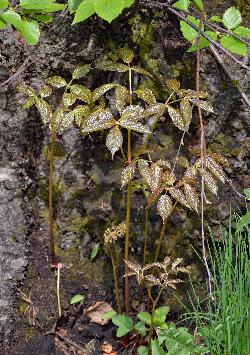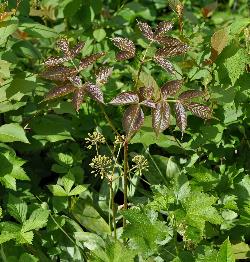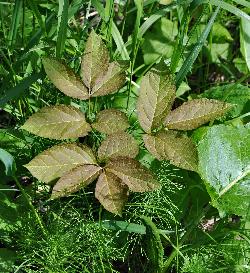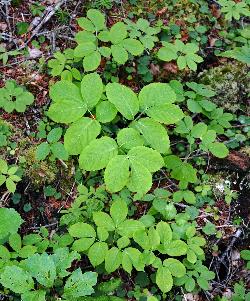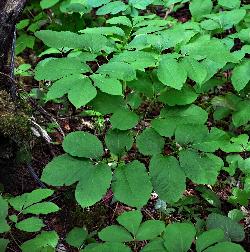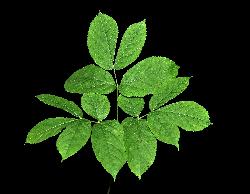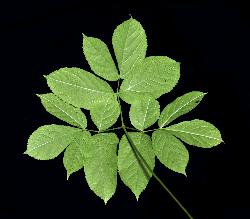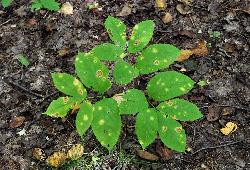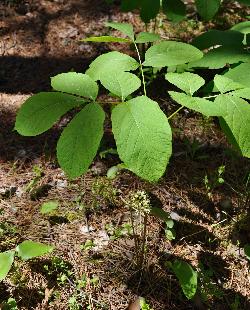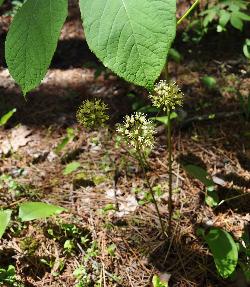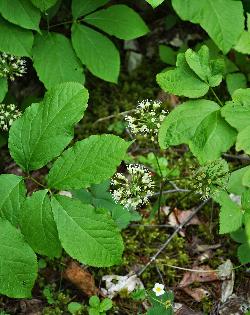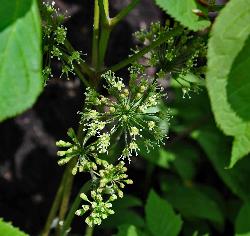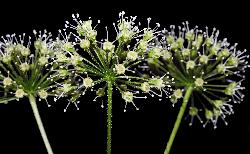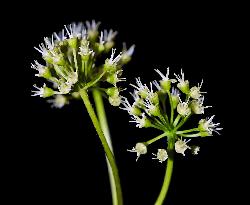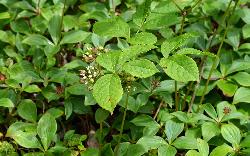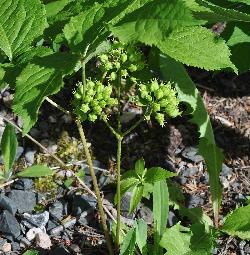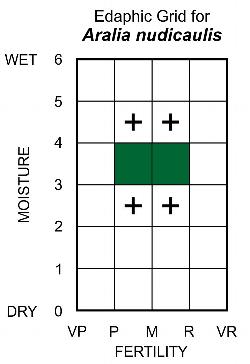Fr: aralie à tige nue, salsepareille
IA: uapushiminakashi, uapushimin (the fruit)
Araliaceae - Ginseng Family
Note: Numbers provided in square brackets in the text refer to the image presented above; image numbers are displayed to the lower left of each image.
General: A perennial acaulescent rhizomatous forb with a single large compound leaf produced at the top of erect branches of the rhizome, often forming clones [1–2]. Wild sarsaparilla spreads primarily by rhizomes, but also reproduces sexually; an erect flowering shoot, usually with 3 umbels is often produced by the erect rhizome, but is often hidden from view beneath the large compound leaf [3–4]. The fruits provide food for black bear and a variety of frugivorous birds, while the vegetation and flowering stems are browsed by moose and caribou (Pavek 1993). The common name, wild sarsaparilla, comes from the historical use of extracts from the plant’s rhizomes used as a substitute for sarsaparilla, a root beer-like soft drink (Fernald 1970); true sarsaparilla is made from the rhizomes of catbrier (Smilax) species, which are vines native to the Mexico and Central America (Holmes 2002). Wild sarsaparilla is currently being investigated as a potential source of anticancer drugs used to treat several different types of cancer (Wang et al. 2006).
Key Features: (numbers 1–3 refer to the illustration [5])
1. Leaves large and ternately compound; of the 2 lateral division of the leaf, the lower (basiscopic) leaflet is about twice as large as the opposite, upper (acroscopic) leaflet.
2. Flowers usually occur in 3 (up to 7) unisexual spherical umbels.
3. The fruit is a bluish-black berry-like drupe, with several drupes borne in a spherical cluster.
Stems: Plants are acaulescent, with no above-ground stems; the thick horizontal rhizome grows 3–12 cm (average 6 cm) below the soil surface and divides periodically to produce an erect branch, or spur shoot, that terminates in a caudex (Flanagan and Bain 1992, Pavek 1993). Within a single growing season, rhizomes can grow for up to 1.5 m and produce 1 or more new ramets (Bawa et al. 1981). Roots are adventitious and develop at each node of the rhizome. Caudices give rise annually to new leaves and flowering shoots. In winter, the caudex is terminated by a scaly overwintering bud, subtended by a leaf scar formed after the single deciduous leaf drops at the end of each year (Flanagan and Bain 1992); leaf scars are narrow, encircle the bud, and have several small vascular trace scars. Each branch of the rhizome and its above-ground shoot represents a ramet of a larger clone. The number of annual leaf scars can be used to age the ramets, which can persist for up to 45 years (Flanagan and Bain 1988, Whitman et al. 1998).
Leaves: A single large compound leaf with 3 main divisions (ternately compound), produced from the caudex of the erect rhizome. The stem-like stalk is actually a stout petiole, 2–4 dm tall. Emerging and young leaves are bronze to deep purplish-green, but become green as they mature [6–7]. Each of the 3 divisions of the leaf are pinnately compound with 2–5, rarely 7 leaflets [8–11], although some plants may be missing one of the 2 paired leaflets. Terminal leaflets are obovate with tapering (cuneate) bases; lateral leaflets are oval, ovate, or obovate, with cuneate to rounded, often oblique bases; apices of terminal and lateral leaflets are abruptly sharp-pointed (acuminate); margins are sharply serrate nearly to the base of each leaflet. Leaflet blades are membranaceous, glabrous above and slightly pubescent and paler beneath [12]. In the two lateral or lower divisions of the leaf, the lower (basiscopic) leaflets are up to 2 or more times as large as the opposite, upper (acroscopic) leaflets; this is particularly pronounced in the pair of leaflets closest to the rachis [11–12]. In the upper division of the leaf, the paired leaflets are similar in size. Later in the season, leaves often become spotted with yellow or brown as they senesce [13].
Flowers: Unisexual and dioecious, with male and female inflorescences borne on separate plants. The flowering shoot develops from the caudex, then splits into 2–7 (usually 3) pubescent (villous) peduncles that bear simple umbels; flowering shoots are shorter than the leaves and often hidden by the large leaves [14–16]. Male inflorescences have more flowers per umbel than those of female umbels. Both male and female flowers have a small glabrous barely-lobed calyx and 5 distinct greenish-white petals that reflex at flowering. Male flower has 5 long-exserted stamens and 5 small non-functioning styles [16–19]; female flowers have a pistil with an inferior ovary composed of 5 carpels, 5 long divergent styles that each terminate in a small capitate stigma, and 5 short stamens with non-functioning anthers [20]. Since wild sarsaparilla is dioecious, cross pollination is necessary for seed set. Flowering occurs in early to mid-summer and continues for about 2–3 weeks (Helenurm and Barrett 1987). Pollination is by insects (entomophily), primarily bumblebees, solitary bees, syrphid flies, and staphylinid beetles (Barrett and Helenurm 1987).
Fruit: A cluster of globose berry-like drupes, about 8 mm in diameter, initially green [21–23], but becoming dark purple to bluish-black at maturity [24]; each fruit contains up to 5 small pits with a single seed inside. Fruits are dispersed by frugivorous mammals and birds (endozoochory), often prior to the fruits reaching maturity (Helenurm and Barrett 1987).
Ecology and Habitat: Wild sarsaparilla occurs, usually in low abundance, in both closed and open forests on medium to rich, moist to wet sites. It is also common on cutovers and burns across a wide range of age classes from early to late seral stages. Wild sarsaparilla is used as a national indicator of nutrient-medium to rich, fresh to moist soils (Ringius and Sims 1998).
Edaphic Grid: See image [25]: the Edaphic Grid for Aralia nudicaulis.
Forest Types: Wild sarsaparilla has been recorded from the following forest types:
Abietum clintonietosum (Clintonia-Balsam Fir Forest Subassociation)
Abietum dryopteretosum (Dryopteris-Balsam Fir Subassociation)
Abietum rubetosum (Rubus-Balsam Fir Forest Subassociation)
Abietum taxetosum (Taxus-Balsam Fir Forest Subassociation)
Carici-Piceetum (Carex-Black Spruce Fen Association)
Osmundo-Piceetum (Osmunda-Black Spruce Fen Association)
Succession: Wild sarsaparilla occurs over a wide range of light conditions, from closed forests to open forested fens, but rarely exceeds 10% cover in Newfoundland forests. It has a well developed long-lived rhizome that penetrates the mineral soil, allowing it to persist after fire and cutting (Pavek 1993). On cutovers in central Newfoundland it was found to have coverage of 10–20% on sites up to 15 years post-harvest (Northland Associates 1989). Moose herbivory can impact wild sarsaparilla populations, with preferential feeding on flowering stems impacting future populations (Edwards 1985).
Distribution: Wild sarsaparilla is a north-temperate to southern boreal species that occurs throughout insular Newfoundland (Rouleau and Lamoureux 1992), but is absent from Labrador (Brouillet et al., 2010+). Within Canada, it has a transcontinental range and occurs in all provinces except Nunavut. In the Unites States, it extends from Maine southwest along the Appalachians to northernmost Georgia and west to North Dakota; its distribution is sparse in the northern Midwest and western States (USDA, NRCS 2016).
Similar Species: Wild sarsaparilla is in the same genus as bristly sarsaparilla, Aralia hispida Vent., which occurs in Newfoundland and Labrador, and can reach up to 9 dm in height. Bristly sarsaparilla, as the name suggests, is armed with sharp bristles along the short caudex, leaf bases, and flowering stems. Bristly sarsaparilla is most easily differentiated from wild sarsaparilla by its several alternate pinnately compound leaves and numerous umbels; it usually occurs in sandy sterile soils, while wild sarsaparilla grows primarily in forested habitats. Another understorey plant with ternately compound leaves is red baneberry (Actaea rubra (Aiton) Willd.). It can be differentiated by its sharply divided, often lobed leaflets, terminal raceme of small white flowers, and clusters of bright red or white berry-like drupes.


